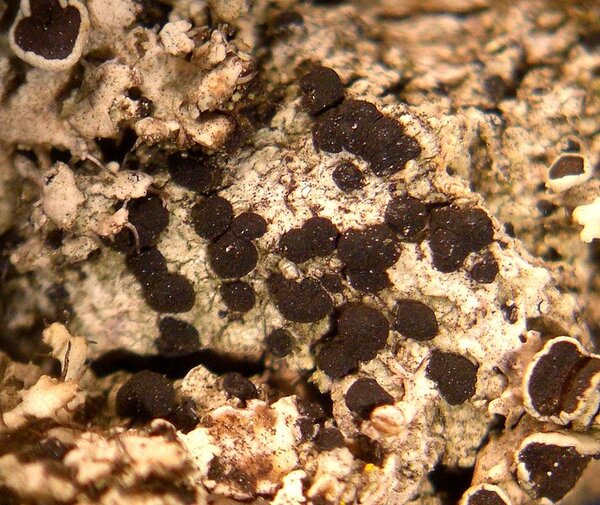Buellia triseptata A. Nordin
Bryologist, 102: 260, 1999.
Synonyms: Buellia lauri-cassiae auct. eur. non (Fée) Müll. Arg.; Buellia triphragmia auct. non (Nyl.) Arnold
Distribution: N - TAA (Nascimbene & al. 2007b), Piem, Lig (Watson 2014). S - Camp, Bas (Ravera & al. 2015d).
Description: Thallus crustose, episubstratic, of variable thickness, continuous to rimose-areolate, whitish, whitish-grey to greyish green, with a smooth to irregular surface, rarely granulose-verrucose. Cortex with numerous crystals of atranorin, sometimes overlain with a thin epinecral layer; medulla white, without crystals, I-. Apothecia lecideine, at first immersed, later adnate to sessile, 0.2-0.7 mm across, with a black, epruinose, flat to slightly convex disc (strongly convex only in overmature apothecia), and a thin, entire, at first slightly prominent later often excluded proper margin. Proper exciple dark reddish brown, more or less uniformly pigmented, sometimes paler in inner part, K-, N-; epithecium dark brown, N-; hymenium colourless, 70-90 µm high, not inspersed with oil droplets; paraphyses 1.5(-2) µm thick in lower part, the apical cells (3-)5-6(-7) µm wide, with a brown cap; hypothecium dark reddish brown. Asci 8-spored, clavate to cylindrical-clavate, the apical dome K/I+ dark blue with a pale, conical-pointed apical cushion (axial mass), the wall I-, but the thin outer gel I+ blue, Bacidia-type. Ascospores 3-septate, brown, mostly curved, ellipsoid with rounded to rarely slightly pointed ends, the median septum thickened in young spores, (14-)16-19(-22) x 5.5-7(-9) µm, when young with Callisporoid inner wall thickenings, with ontogeny of type C. Pycnidia rare, black, largely immersed. Conidia bacilliform, 4-6.3 x c. 1 µm. Photobiont chlorococcoid. Spot tests: thallus K+ pale yellow or K-, C-, KC-, P- or P+ faintly yellow. Chemistry: atranorin, often in low amounts.Note: mainly lignicolous, more rarely on the bark of conifers in upland areas: a critical taxon, which needs further study (see Nimis 1993: 145). It is included in the Italian red list of epiphytic lichens as “Critically Endangered” (Nascimbene & al. 2013c).
Growth form: Crustose
Substrata: lignum
Photobiont: green algae other than Trentepohlia
Reproductive strategy: mainly sexual
Poorly known taxon in need of further study
Commonnes-rarity: (info)
Alpine belt: absent
Subalpine belt: very rare
Oromediterranean belt: absent
Montane belt: very rare
Submediterranean belt: absent
Padanian area: absent
Humid submediterranean belt: absent
Humid mediterranean belt: absent
Dry mediterranean belt: absent

Predictive model
Growth form: Crustose
Substrata: lignum
Photobiont: green algae other than Trentepohlia
Reproductive strategy: mainly sexual
Poorly known taxon in need of further study
Commonnes-rarity: (info)
Alpine belt: absent
Subalpine belt: very rare
Oromediterranean belt: absent
Montane belt: very rare
Submediterranean belt: absent
Padanian area: absent
Humid submediterranean belt: absent
Humid mediterranean belt: absent
Dry mediterranean belt: absent

Predictive model
 Index Fungorum
Index Fungorum
 GBIF
GBIF




